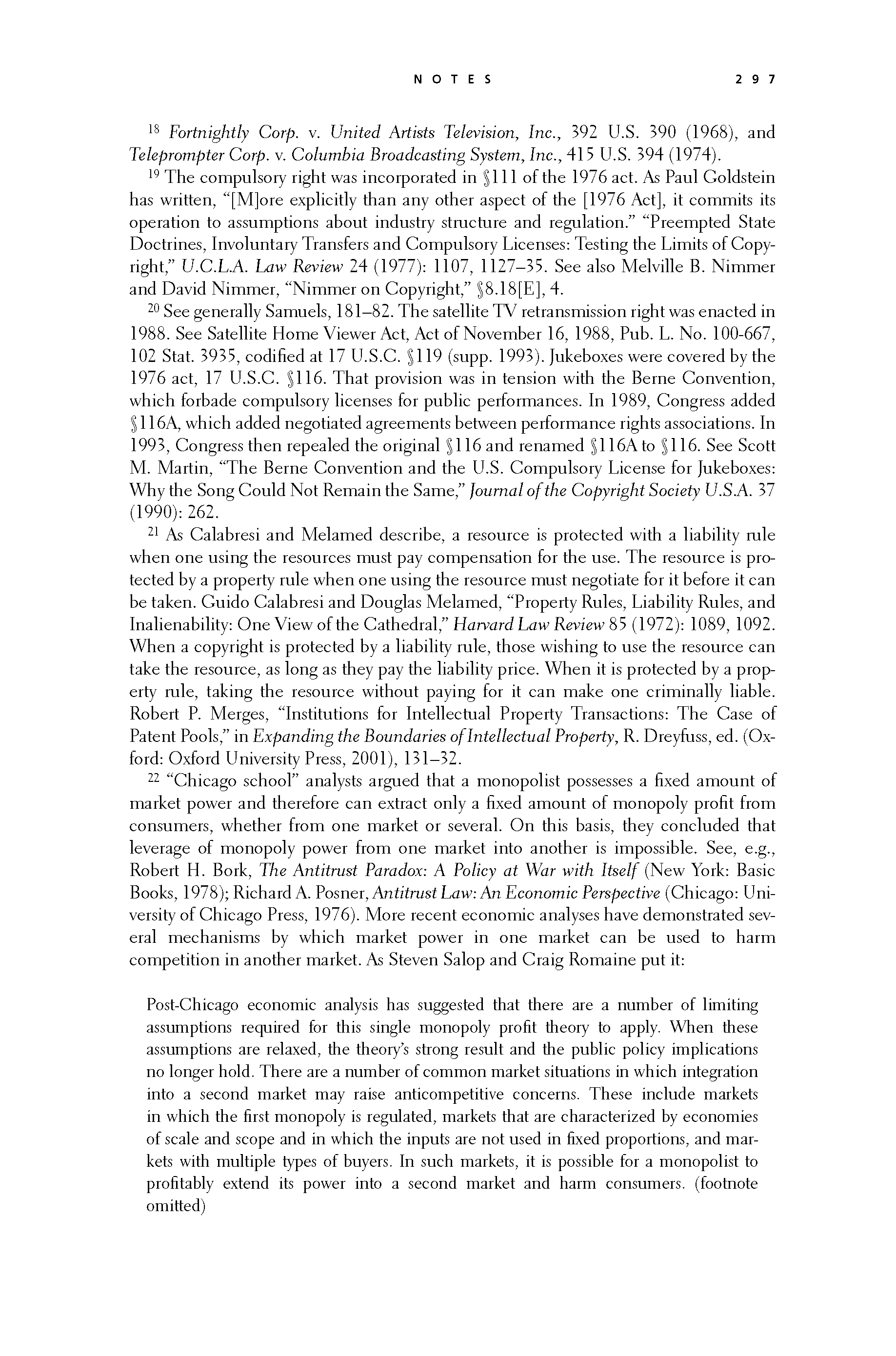 p296 _
-chap- _
toc-1 _
p297w _
toc-2 _
+chap+ _
p298
p296 _
-chap- _
toc-1 _
p297w _
toc-2 _
+chap+ _
p298
[7-18] _Fortnightly_Corp._ v. _United_Artists_Television,_Inc.,_ 392 U.S. 390 (1968), and
_Teleprompter_Corp._ v. _Columbia_Broadcasting_System,_Inc.,_ 415 U.S. 394 (1974).
[7-19] The compulsory right was incorporated in #111 of the 1976 act. As Paul Goldstein
has written, "[M]ore explicitly than any other aspect of the [1976 Act], it commits its
operation to assumptions about industry structure and regulation." "Preempted State
Doctrines, Involuntary Transfers and Compulsory Licenses: Testing the Limits of Copy-
right," _U.C.L.A._Law_Review_ 24 (1977): 1107, 1127-1135. See also Melville B. Nimmer
and David Nimmer, "Nimmer on Copyright," #8.18[E], 4.
[7-20] See generally Samuels, 181-182. The satellite TV retransmission right was enacted in
1988. See Satellite Home Viewer Act, Act of November 16, 1988, Pub. L. No. 100-667,
102 Stat. 3935, codified at 17 U.S.C. #119 (supp. 1993). Jukeboxes were covered by the
1976 act, 17 U.S.C. #116. That provision was in tension with the Berne Convention,
which forbade compulsory licenses for public performances. In 1989, Congress added
#116A, which added negotiated agreements between performance rights associations. In
1993, Congress then repealed the original #116 and renamed #116A to #116. See Scott
M. Martin, "The Berne Convention and the U.S. Compulsory License for Jukeboxes:
Why the Song Could Not Remain the Same," _Journal_of_the_Copyright_Society_U.S.A._ 37
(1990): 262.
[7-21] As Calabresi and Melamed describe, a resource is protected with a liability rule
when one using the resources must pay compensation for the use. The resource is pro-
tected by a property rule when one using the resource must negotiate for it before it can
be taken. Guido Calabresi and Douglas Melamed, "Property Rules, Liability Rules, and
Inalienability: One View of the Cathedral," _Harvard_Law_Review_ 85 (1972): 1089, 1092.
When a copyright is protected by a liability rule, those wishing to use the resource can
take the resource, as long as they pay the liability price. When it is protected by a prop-
erty rule, taking the resource without paying for it can make one criminally liable.
Robert P. Merges, "Institutions for Intellectual Property Transactions: The Case of
Patent Pools," in _Expanding_the_Boundaries_of_Intellectual_Property,_ R. Dreyfuss, ed. (Ox-
ford: Oxford University Press, 2001), 131-132.
[7-22] "Chicago school" analysts argued that a monopolist possesses a fixed amount of
market power and therefore can extract only a fixed amount of monopoly profit from
consumers, whether from one market or several. On this basis, they concluded that
leverage of monopoly power from one market into another is impossible. See, e.g.,
Robert H. Bork, _The_Antitrust_Paradox:_A_Policy_at_War_with_Itself_ (New York: Basic
Books, 1978); Richard A. Posner, _Antitrust_Law:_An_Economic_Perspective_ (Chicago: Uni-
versity of Chicago Press, 1976). More recent economic analyses have demonstrated sev-
eral mechanisms by which market power in one market can be used to harm
competition in another market. As Steven Salop and Craig Romaine put it:
____ Post-Chicago economic analysis has suggested that there are a number of limiting
____ assumptions required for this single monopoly profit theory to apply. When these
____ assumptions are relaxed, the theory's strong result and the public policy implications
____ no longer hold. There are a number of common market situations in which integration
____ into a second market may raise anticompetitive concerns. These include markets
____ in which the first monopoly is regulated, markets that are characterized by economies
____ of scale and scope and in which the inputs are not used in fixed proportions, and mar-
____ kets with multiple types of buyers. In such markets, it is possible for a monopolist to
____ profitably extend its power into a second market and harm consumers. (footnote
____ omitted)
[[297]]
p296 _
-chap- _
toc-1 _
p297w _
toc-2 _
+chap+ _
p298